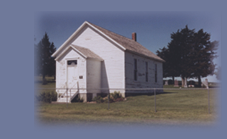| |
|
| |
Beginning: |
| |
The
earliest recorded burial in the Postville Community was John Williams,
August 21, 1879, at the age of 36. This was followed by three burials
in 1880. They were buried in a plot of land that was near the main
wagon trail and where the present cemetery is located today.
The First Welsh Calvinistic Methodist Cemetery preceded the building
of the church by several years, but is located on the same land as
the Church. |
| |
|
| |
The cemetery has accepted burials since 1879 and will continue into
the future as requests are being accepted at the present time. Those
buried in the cemetery are mostly of Welsh descent and were part of
the past Postville, Nebraska Welsh community that was located a short
distant away and surrounding homesteaders. |
| |
|
| |
There
are four known burials in the cemetery before the 1881 Articles of
Association By Laws and Constitution were written to form the First
Welsh Calvinistic Methodist Church and four years before the building
of the wood frame church. On July 10, 1884, David and Mary Thomas
deeded two (2) acres of their wild prairie land to the church for
the purpose of a cemetery and for the building of the church.
It is not known when the cemetery was first layed out. Burial lots
were indicated by burying pieces of iron and wooden stakes. The cemetery
was layed out with intermittent East-West and North-South twelve foot
walk ways. |
| |
|
| |
The
earliest recorded burial was August 21, 1879 as John Williams at the
age of 36 years. It is not known when the first burials were made
but in the area where this headstone stands several depressions are
seen in the soil that indicate a grave sites. In 1966 Leonard Thomazin
of St. Edward, Nebraska surveyed the cemetey for additional grave
sites. The surveyor followed the original layout. Upon completion
of the survey a map was drawn. |
| |
|
| |
During
a recent time of cemetery maintenance, ground level head stones were
found eight inches below the soil surface. It is believed that these
and other possible graves, were covered by dirt during the early 1930's
when the lack of rain caused the dirt to be blown by the winds that
blew across the great plains of the United States. These times were
known as the great dust bowl years. |
| |
| |
| |
|
| |
|



